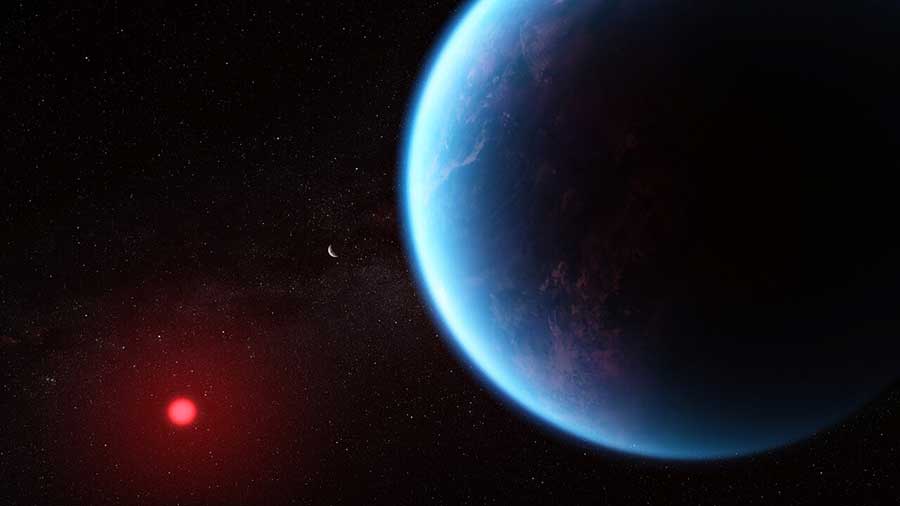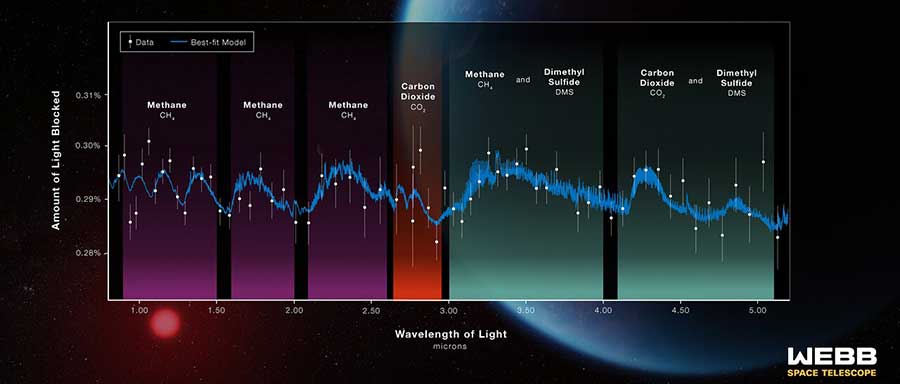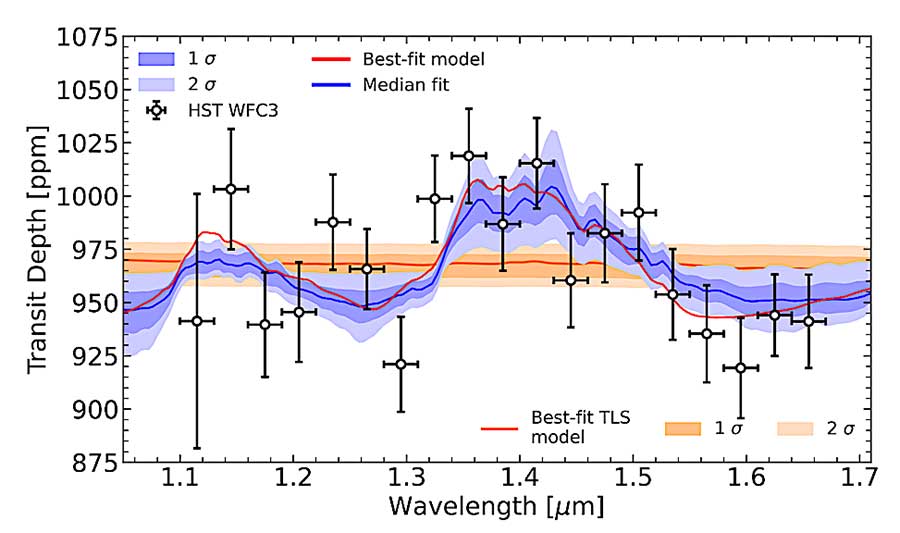Data coming from the Webb and Hubble space telescopes suggests two exoplanets might be water worlds. But the evidence isn’t yet definitive.

NASA, CSA, ESA, J. Olmstead (STScI), N. Madhusudhan (Cambridge University)
Planets a bit bigger than Earth and a bit smaller than Neptune are the most common in our galaxy. And there’s not a single one in our solar system.
“They’re super intriguing because we don’t have anything like this in the solar system,” says astronomer Björn Benneke (University of Montreal). “And they might be a completely new class of planet.”
Two recent discoveries highlight the promise and perplexity of characterizing these abundant, mysterious worlds. JWST observations of the temperate sub-Neptune exoplanet K2-18b revealed a cocktail of gases in its atmosphere that some astronomers have interpreted as evidence for a global surface ocean on the planet.
And, using Hubble, astronomers spotted signs of water vapor in the atmosphere of hotter, smaller GJ 9827d, which is twice as wide as Earth. That makes this world the smallest exoplanet with an atmospheric molecular detection to date.
The research teams behind both observations believe their findings hint at water-rich compositions and, in the case of K2-18b, a potentially habitable global ocean. But while the discoveries make both planets promising “water worlds,” other scenarios can’t yet be ruled out.
Water Worlds or Gas Dwarfs
“The big question hovering around sub-Neptunes,” says Raymond Pierrehumbert (University of Oxford, UK), “is to what extent are their atmospheres hydrogen-dominated?”
Until relatively recently, scientists could only guess at the composition of sub-Neptunes by calculating their average densities from measurements of their mass and girth. Rocky worlds like Earth are dense, while fluffy, hydrogen-dominated planets like Saturn and Neptune are not. Sub-Neptunes, frustratingly, fall somewhere in between.
This has led some scientists to propose that these in-between planets could be exotic water worlds, made almost entirely of different phases of water — unlike anything in our solar system. But the measured densities of sub-Neptunes are only an average, and they could just as easily fit planets with dense cores wrapped in thick blankets of hydrogen, a bit like our familiar gas giants. Density alone can’t discriminate between these two possibilities, or intermediate scenarios such as “Hycean” worlds, ocean worlds with thin hydrogen atmospheres.
Now, scientists are trying to catch glimpses of sub-Neptunes’ atmospheres using transit spectroscopy, measurements taken by watching a star dim as a planet passes in front of it. Starlight passing through the planet’s atmosphere interacts with molecules, changing the planets’ apparent size depending on the wavelength of light. Astronomers can analyze these observations to figure out what the atmosphere is made of.
However, this technique “only probes the thin outer skin of the atmosphere,” says Pierrehumbert. Starlight can’t penetrate the depths of thick atmospheres. So astronomers must infer what's going on deep inside planets’ atmospheres based only on the composition of the upper part.
K2-18b: You Could Go Both Ways
Using JWST, astronomer Nikku Madhusudhan (University of Cambridge) and colleagues announced recently that they’d found carbon-bearing molecules in the atmosphere of a habitable-zone planet — K2-18b — for the first time. The study will appear in Astrophysical Journal Letters.
Madhusudhan’s team found methane and carbon dioxide — but no ammonia — in this world’s hydrogen-rich atmosphere. Astronomers expect ammonia in thick hydrogen atmospheres, so its non-detection could hint that K2-18 b has a more watery, less hydrogen-dominated composition.

“What we can say is that there ought to be a water world — a water layer underneath a thin hydrogen-rich atmosphere,” says Madhusudhan. “Whether that water layer is habitable or not is a different question.”
Pierrehumbert has his doubts, though. He’s not convinced that the absence of ammonia indicates a water world. “I don't think the answer is that there's a liquid ocean down there,” he says. Instead, he thinks there’s likely something about ammonia chemistry and atmospheric mixing within sub-Neptunes that astronomers don’t understand yet.
Even if the planet is a water world, he adds, the hydrogen atmosphere’s greenhouse effect could drive surface temperatures so high that the planet’s “ocean” would be more of an uninhabitable sheath of supercritical water — a possibility that Madhusudhan acknowledges.
“There are arguments for it, there are arguments against it,” Madhusudhan says. “You could go both ways.”
Hubble and Webb, Water and Methane
Hubble observations published September 12th in Astrophysical Journal Letters by Pierre-Alexis Roy (also at University of Montreal), Benneke, and colleagues strengthen the case for GJ 9827d as another candidate water world — albeit a steamy one, with a calculated temperatures around 400°C.
The team pooled observations from the 33-year-old Hubble of 11 planet transits. JWST is more powerful and can see further into the infrared than Hubble, but Hubble has been in the sky for decades longer. “In this case, it had a bit of a head start, because we started observations way before JWST even existed,” says Benneke.

Roy et al. / Astrophysical Journal Letters 2023
Even with 11 transits, there are some questions Hubble just can’t answer. The absorption signatures of water and methane appear similar in Hubble data because it doesn’t extend far enough into the infrared to see features that distinguish the two molecules. In fact, in 2019, astronomers thought Hubble had spotted water in K2-18b’s atmosphere. But Madhusudhan’s new analysis of JWST data revealed that that signal actually came from methane — the planet’s high atmosphere is dry.
So it's conceivable that what looks like water on GJ 9827d could turn out to be methane, too, say Benneke and Pierrehumbert. JWST could clear that up, and follow-up observations of GJ 9827d — and K2-18b, along with a few other sub-Neptunes — are already planned, says Benneke.
The aim is to do more than merely detect the presence or absence of certain gases on sub-Neptunes. Astronomers ultimately want to use JWST to measure the concentrations of those atmospheric gases. That, says Benneke, could go a long way toward distinguishing fluffy hydrogen balls from Hycean worlds and true water worlds.
“In the end, the main goal is not to find some methane, or to find some water vapor. What we really want to do is to distinguish between those two scenarios,” he says. “That is what we want to distinguish — what Webb can eventually deliver.”
 0
0









Comments
You must be logged in to post a comment.